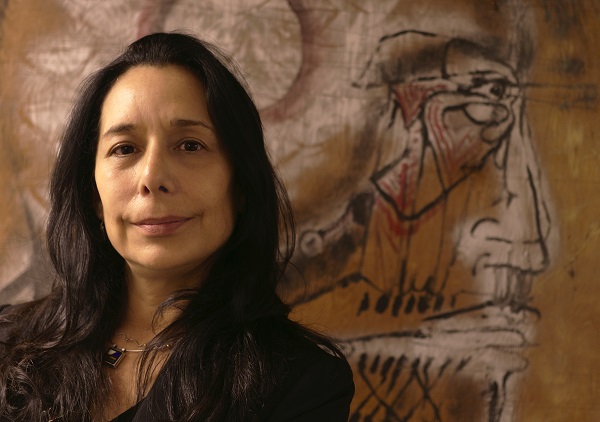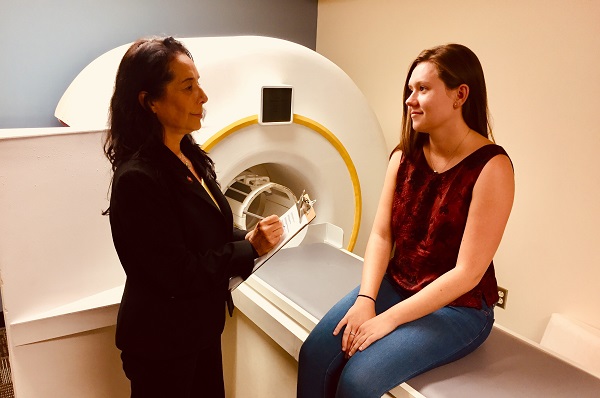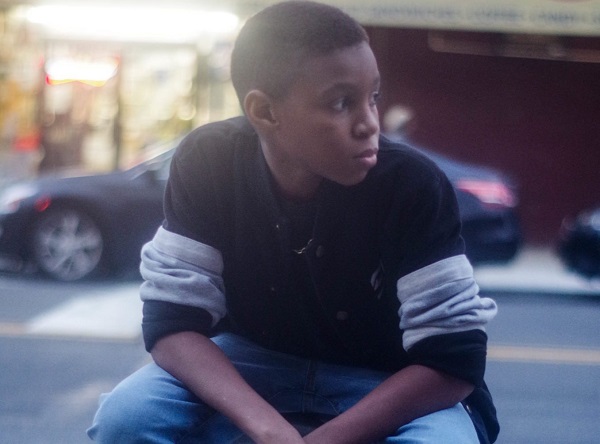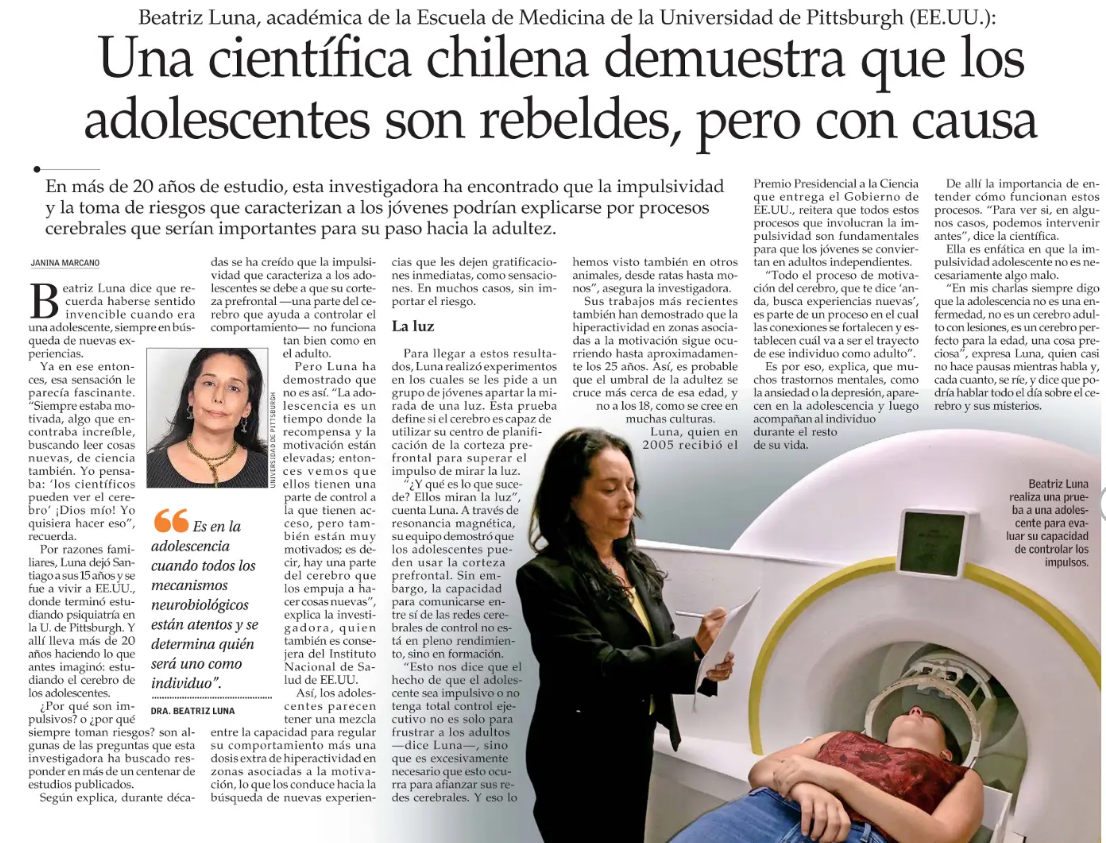Follow our Facebook page for more immediate updates.
Take a fascinating tour of the teenage brain with Pittsburgh researcher Dr. Beatriz Luna

Sandra Tolliver
April15/ 2020
Teens everywhere ignored the coronavirus shelter-at-home edict and joined their friends at the local park, either unaware or defiant of the need for social distancing.
College kids flocked to Florida beaches for spring break early in the public health crisis, sending shock waves over social media platforms where the photos and videos went viral.
And adults everywhere asked: What could they be thinking?
Dr. Beatriz Luna understands the teens’ behavior. The University of Pittsburgh professor of psychiatry studies the brains of adolescents and young adults. She says we shouldn’t be surprised at their need to engage in risky, sensation-seeking behavior. Quite simply, they learn through experiences — good and bad.
“We’ve really been interested in the transition from adolescence to adulthood for many reasons,” says Luna, of Highland Park, the director and principal investigator at Pitt’s Laboratory of Neurocognitive Development. “People think of it as a broken-down part of the lifespan — these crazy teens — but in fact, it is how individuals can gain that new experience that will help them gain independence as adults.”
Adolescence also is a time when psychiatric illnesses start to emerge, so studying young minds can help to understand brain-based changes. Adolescence begins around age 10, and there’s some evidence that the brain may still be developing much longer than previously thought, into one’s thirties, Luna says.
At any given time, Luna has around 200 young people enrolled in studies that are ongoing at the lab, following them sometimes for years. She recruits adolescents and teens through advertising, word of mouth and partnerships with the city and schools. They’re paid a fee, typically $250, to come in and perform actions such as playing a computer game while hooked to an MRI and then an EEG. They return 18 months later for a follow-up.
In addition to her work at Pitt, Luna is co-investigator with Pitt’s Duncan Clark for the Allegheny County Adolescent Brain Cognitive Development (ABCD) study, a $300 million National Institutes of Health initiative for which Pittsburgh is one of 24 sites. Researchers across the country are studying 11,000 youths, ages 9-19, to understand how their brains change.
Critical development
“We’re looking at a sensitive period or critical period,” says Luna. “Adolescence is a time when things are really shaping in a way that they’re not shaped at any other time in the lifespan. Things that are occurring in adolescence will determine who you are. You’re born with a neurobiological genetic disposition; it’s who you are. Your particular environment, that’s predisposition. The system is trying to fit and adapt to the demands of the environment. When adolescence comes, it’s a time when the brain says, ‘OK, we’re going to figure out what you’ve been using and haven’t been using.’”
Teens typically act on impulse and sometimes against their better judgment, she says, because the brain seeks reward to enhance their emotions. However, even though reward and emotion win over cognitive decisions, Luna’s research shows that a teen isolated in the laboratory without the influence of friends “can demonstrate adult-level cognition, though we still see elevation of reward and emotion.
“What we are thinking is that adolescence actually is a time when everything is there,” Luna says, “including decision-making abilities, but it’s driven by heightened reward, sensitivity and emotion. It could be seen as a way for the brain to say, ‘OK, I’ve given you everything. Now I’m going to give you a big push — go and make decisions.’”
Luna doesn’t like using the word “imbalance” or other terms that might suggest there’s anything wrong with adolescence. “It has its own particular balance,” she says. “You’ve gotten hold of adult-level, executive functions but they’re being driven by reward and emotion. It’s like learning how to drive: it can be undermined by having peers around, getting super excited.”
Action and consequence
Sometimes her studies seem deceptively simplistic — for example, the anti-saccade task, where she’ll instruct a teen not to look at a light that pops on.
“They look at the light. They’ll say, ‘I know what you wanted me to do, but I was not able to.’ When they do it correctly, they use the prefrontal cortex,” she explains, which relates to planning complex cognitive behavior and decision making. “When they do it wrong, an alarm system in the brain alerts them. In adolescence, we don’t see that alarm sounding off at the same volume as adults. … This alarm doesn’t go off because then you wouldn’t be trying new things.”
It may help parents to know that engaging with a teen — talking with them about right and wrong and the consequences that may follow actions — can make a difference in their decisions.
“There’s a lot of variability in how the brain is being engaged when asked to do an executive task,” Luna explains. “There’s a lot less variability as you become an adult. With sensation seeking, the brain is doing that as well — it’s experimenting and trying different ways of being able to generate executive behavior. … An adolescent talking with an adult, without distraction, can access their executive system — they’re owning it.”
It’s important, too, for parents, teachers and others who work with young people “to recognize that they have this heightened drive toward short-term rewards,” Luna says. “That is something to take into consideration if you’re thinking of distraction, but also could be used to leverage what they’re going to do. If I say, ‘Don’t look at the light,’ if you give them a reward, magically they can do it right.”
She tells parents to inform their kids about possible outcomes – even if you can’t stop their reckless behavior. Adolescents are shortsighted, but you can give them the long-term effects of what could happen.
Sensation-seeking is normal and it’s going to happen. “I was a crazy adolescent, too, but here I am,” she says. “Keeping the door open is so important, so they know they can come of their own volition to seek help if they need it. You’ll be talking to an adolescent, and they act like they don’t care, but the brain can’t help but process that information. Don’t give up, even if they’re giving you that scowl.”
Homegrown research
Luna’s work with young people started coincidentally when her own son and daughter reached adolescence. Her husband, Dennis Childers, is an artist and musician who teaches at Pittsburgh CAPA.
“We have great conversations. He always says there’s that summer, typically 9th grade, when [students] come back and they’re totally different,” she says. “He knows how to talk to teenagers so well. He’s had a lot of kids who have come up and said to him, ‘I’ve been told I’m good for nothing,’ but my husband sees talent in all of them.”
Above all, Luna believes in giving adolescents a fair chance.
“Adolescence is not a disease. It’s an amazing time of life that we have to understand so we can make it the best possible,” she says. “The potential there is amazing because that’s going to determine the boundaries of who you are as an adult.”
This story is part of the Kidsburgh Mental Health Series funded by a grant from the Stanton Farm Foundation. The Foundation is dedicated to improving the lives of people who live with mental illness or substance use disorders. The Foundation’s vision is to invest in a future where behavioral health is understood, supported, and accepted.
Other stories in the series include the Kidsburgh Mental Health Survey report, insight as to how parents can deal with coronavirus anxiety and advice on remaining resilient during times that try your family’s mental health.Tags: Adolescent Brain Cognitive Development, Dr. Beatirz Luna, University of Pittsburgh← PREVIOUS POST
Sandra Tolliver
Connect with Sandra Tolliver
Sandra Tolliver is a freelance writer, editor and public relations professional in Upper St. Clair.
image of a man reading in a bare cell-like room, with the word “Caught” in bold, red font on the top and “WNYCSTUDIOS” at the bottom of the picture.
Caught – a podcast from WNJP Radio – FM
All kids make dumb mistakes. But depending on your zip code, race, or just bad luck, those mistakes can have a lasting impact. Mass incarceration starts young. In Caught: The Lives of Juvenile Justice, hear from kids about the moment they collided with law and order, and how it changed them forever.
Dr. Luna is featured in episode 5, ‘The Teenage Brain Is Like a Sports Car’.’ Stephen is one of thousands of so-called “juvenile lifers” who have an unexpected shot at freedom today. Up until 2005, most juveniles could be sentenced just as harshly as adults: that meant life without parole, even the death penalty. Then a landmark Supreme Court decision made executing juvenile offenders illegal, and sentencing guidelines began to change. The court was swayed after hearing about teenage brain development.
Dr. Beatriz Luna – Entrevista Televisiva en Chile
Sorry, no English translation.
Translation:
Beatriz Luna, Professor at the School of Medicine at the University of Pittsburgh (U.S.A.): A Chilean Scientist Shows that Adolescents are Rebels, but with a Cause
-Janina Marcano
In more than 20 years of research, this investigator has found that the impulsivity and risk-taking that characterize youth can be explained by cerebral processes that are important for the transition to adulthood.
Beatriz Luna says she remembers feeling invincible when she was a teenager, always looking for new experiences. Even then, sensations fascinated her. “I was always motivated, something that I found incredible. I would look for new things to read, scientific things too. I thought, ‘scientists can see the brain’ my God! I would like to do that.”
For family-related reasons, she left Santiago at age 15 and moved to the U.S. where she finished her studies in Psychiatry at the University of Pittsburgh. Now she has spent more than 20 years doing just what she had imagined: studying the adolescent brain.
Why are they so impulsive? Or, why are they always taking risks? These are some of the questions this investigator is trying to answer in more than a hundred published studies.
As she explains, for decades it has been thought that the impulsivity that characterizes adolescence was due to the prefrontal cortex – a part of the brain that helps to control behavior – not functioning as well in adolescence as during adulthood.
But Luna has shown that this is not the case. “Adolescence is a period during which reward and motivation are elevated; so we see that they have access to some control, but are also very motivated; in other words, there is a part of the brain that pushes them to do new things,” explains the investigator, who is also an advisor for the National Institute of Health.
So, adolescents seem to have a mix between the capacity to regulate behavior and an extra dose of hyperactivity in areas associated with motivation, which leads them to seek out new experiences that give them instant gratification, like sensations. In many cases, without caring about the risk.
The Light
To arrive at these results, Luna did experiments in which a group of adolescents was asked to look away from a light. This question shows whether the brain is capable of using the planning area of the prefrontal cortex to suppress the urge to look at the light. “And what happens? They look at the light,” says Luna. Using magnetic imaging, her team shows that adolescents can use the prefrontal cortex. Nevertheless, the capacity for communication between control networks of the brain is still developing.
“This tells us that the fact that adolescents are impulsive or don’t have full executive control isn’t just to frustrate adults,” says Luna, “but that it is absolutely necessary that this occurs to support the neural network development. And this we have also seen in other animal, from rats to monkeys,” explains the investigator.
Her most recent works also have demonstrated that the hyperactivity in zones associated with motivation continues until approximately 25 years of age. So, it is probable that the threshold of adulthood begins closer to this age, not 18, as is believed in many cultures.
Luna, who in 2005 received the Presidential Prize in the Sciences from the U.S. government, reiterated that all of these processes that involve impulsivity are fundamental for the development of adolescents into independent adults.
“The entirety of the motivational brain process that is saying ‘go, look for new experiences,’ is part of a process in which the connections are strengthened and the individual’s trajectory toward adulthood is established.”
Because of this, she explains, many mental disorders, such as anxiety or depression, appear in adolescence and later affect the individual for the rest of their life.
So for this reason, it is important to understand how these processes function. “To see if, in some cases, we can interfere before [the onset of the disorder],” say the scientist.
She is emphatic that adolescent impulsivity is nothing bad.
“In my talks I always say that adolescence is not a sickness, nor is it an adult brain with lesions, it is a perfect brain for the age, a precious thing,” expresses Luna, who almost doesn’t take pauses between speaking, and when she does, it is to laugh and say she could talk all day about the brain and its mysteries.
Image text: Beatriz Luna does a test on an adolescent to evaluate their capacity to control their impulses
“Brains on Trial” series with Alan Alda.
The Teenage Brain in the Media!
In October 2011 National Geographic published an article about teenage brain development titled “Beautiful Brains” by David Dobbs. In it LNCD director Dr. Beatriz Luna, among other scientists, speaks about our research and what we know about the adolescent brain. We’re excited to be featured in such an esteemed magazine – please check it out below!
Beautiful Brains
Dobbs, D (Oct 2011) Beautiful Brains. National Geographic Magazine, 36-59.
Neurons to Neighborhoods Focuses on the Teen Brain
Roth, M (Oct 27, 2017) Carnegie Mellon University Brain Hub.
Kidults: Does delaying responsibility affect our brains?
Bambury, B (Feb 21, 2015) Day 6 with Brent Bambury, CBC Radio.
We’re kidults in our 20s
Radowitz, JV (Feb 15, 2015) Press Association.
Adulthood begins at 25, says new research
Tufft, B (Feb 15, 2015) The Independent.
Don’t blame the teenage brain for risk-taking
Byko, L (Feb 15, 2015) Pitt prof’s research questions traditional thinking on matter, Pittsburgh Post-Gazette.
A Delicate Balance: Risk, Reward, and the Adolescent Brain
Sherman, Carl. (Oct. 2012) A Delicate Balance: Risks, Rewards, and the Adolescent Brain. The Dana Foundation.
Why Teens are Wired for Risk
Landau, Elizabeth. (Oct 2011) Why Teens are Wired for Risk. CNN.com.
Probing the Brain Power of Pitt
Baum, M (May 23 2011) Action Potential: Probing the Brain Power of Pitt Neuroscience, 4-5 Pitt Chronicle.
Understanding Voluntary Behavior
Luna B (Jan 21, 2011) Understanding Voluntary Behavior New York Times, Opinion Page.


